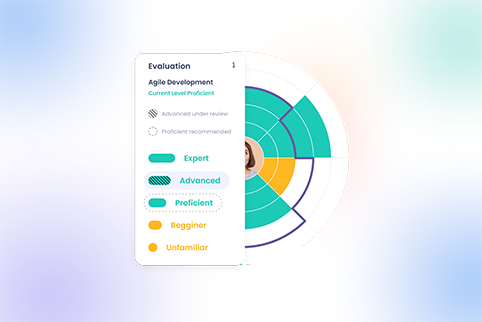
Times have changed. The world of work in which the default career progression was to get a degree, find an entry-level job, and then advance through the ranks to a management position is going away. We now live in more exciting times, where non-linear career paths are taking over.
By recognizing and supporting the need and advantages of these diverse career trajectories, businesses can foster a culture of innovation, resilience, and creativity that drives sustainable growth and success in an ever-changing world.
In this article, we look at the rising prominence of non-linear career paths and explore how forward-thinking organizations can harness their benefits to attract, nurture, and retain agile, multi-skilled professionals. Let’s dive right in!
Why are non-linear career paths increasing in popularity?
Multiple factors are behind the shift to a non-linear career progression, including:
Changes caused by the pandemic
Looking at events from the last years, the pandemic is one of the main ‘culprits’ that have determined people to reconsider their career paths and long-term plans. The stress of the whole situation, the uncertainty, and the confirmation that working from home can be just as effective as working from an office — all contributed to a major shift in perspectives and priorities.
And that’s not all. Another important side effect, according to Wendy Makinson, HR Manager at Joloda Hydraroll, is the fact that:
Due to a broader range of career options in a post-covid world, and with remote work combined with inline learning (vast access to free learning resources), there are more resources than ever to provide career development opportunities for anyone looking to make a career change.
— Wendy Makinson, HR Manager at Joloda Hydraroll
An increased need for organizational agility
From the point of view of organizations, disruptions experienced in the last years have pushed the need for agility, which has become as important — if not more important — than stability. In this context, adopting and promoting dynamic career paths and horizontal growth have become key initiatives.
Combine this change in business needs with emerging technologies (like generative AI) and automation and you’ll understand why non-linear career paths are seen as a win-win by both employers and employees.
According to Matt McFarlane, Senior Director of People Experience at Oyster, “Organizations have had to become increasingly agile in order to adapt and evolve to the instability of the external environment — from drastic economic fluctuations to a global pandemic and rapid improvements in technology. This breeds a requirement for adaptability, resilience, and change management that has seeped its way into the emergent workforce of younger professionals.”
Shifts in values and perspectives among workers
Another factor is a change in values, especially among younger generations in the workforce. Financial and job security are no longer paramount. Personal fulfillment, work-life balance, and having a sense of meaningful connections and relationships have all skyrocketed in terms of importance.
Matt McFarlane highlights the combination of a deep desire for growth with lower levels of patience:
“This (young) workforce is increasingly hungry for growth, development and progression, and organizations that aren’t able to satiate that hunger through upward mobility (the traditional career ladder) are increasingly needing to evaluate the ways in which they can enable their talent to move non-linearly in order to not only satisfy this need but to attract and retain critical talent in a volatile and challenging skills market.”
The normalization of new concepts, like the gig economy or side hustles
The impact of social media on new workforce generations shouldn’t be underestimated, especially knowing that Gen Z workers are expected to represent the majority of employees in the near future. Matt further adds to this point by explaining that:
“Incoming professionals are comfortable and highly familiar with the concept of influencers and gig-economy side hustles, which are highly normalized across much of the social media they engage daily.”
Linear or vertical career paths can be limited and limiting
Bettina Byrd-Giles, who is a Consultant at The Byrd’s Nest, explains better than most how and why vertical career progression simply isn’t an option for everyone:
“Linear paths are great in theory. However, the math just doesn’t add up. Not everyone can move to the top of a career ladder. The closer one gets to the top, the fewer the opportunities. Therefore, one has the option of staying put or finding another opportunity, thus disrupting the idea of a linear career progression.
A linear path limits one’s choices. A linear path is influenced by the progression of those in front or above you. A meandering or nonlinear path provides multiple options and career choices.”
Living longer also means working longer
People are increasingly aware that longer life spans also mean longer careers. And in this context, remaining in the same line of work can become stressful and demotivating over time, regardless of how interesting or complex the field is initially.
It’s easy to end up feeling stuck, especially when opportunities to keep learning and growing, to do challenging work are not available. And that’s when a deep desire for change emerges.
Concerns regarding automation and the rise of AI
Emerging trends and shifts in the labor market are also key factors behind the rising popularity of non-linear career paths. Technology is advancing fast and not all workers can keep up the pace, who already pay the price for the digital skills gap.
As Dr. Kyle Elliott, Founder and Tech Career Coach at CaffeinatedKyle.com shared with us: “Workers are responding to the labor market. Many of the jobs that exist today didn’t a decade ago. Additionally, the latest wave of AI is changing the types of jobs that are available. In other words, it’s not possible to have a linear career path if your job didn’t exist when you began your career or it’s extinct 5 years from now.”
Non-linear career paths vs linear career paths
Linear career paths were the perfect fit for most employees during the Third Industrial Revolution. The map to professional success was simple and clear to everyone willing to work and rise through the ranks. One vertical move led to another until an employee eventually reached a top management or leadership position, in which they’d normally stay until retirement.
Non-linear career paths are a natural response to the upcoming Fourth Industrial Revolution and the age of AI which we’ve entered, according to Bill Gates. It is a concept that allows and encourages employees to explore diverse roles and experiences across different departments or even industries.
The progression is often times lateral, instead of vertical, and the accent is on exploring novel roles and developing new skills and expertise or, at least, applying part of the existing abilities in another business or industry area.
You might also see non-linear career progression referred to as agile, flexible, or even dynamic career paths. But it shouldn’t be confused with job hopping — the practice of changing multiple jobs in a short period of time without a clear plan or outcome in mind. This is especially common among Gen Z workers.
What are the benefits of non-linear career paths?
Let’s explore some of the main benefits of adopting non-linear career progression in your organization:
- Higher agility and adaptability: Employees who have experience in different roles are generally more flexible and adaptable to change. Their broader skill set and expertise will enable them to handle transitions and organizational shifts much better.
- Improved engagement and satisfaction: Seeing the person behind the worker and allowing them to follow their interests and passions will boost both engagement and satisfaction levels. And, in turn, the company will enjoy more productivity and higher-quality work.
- Increased retention and loyalty: Accommodating non-linear career paths will significantly impact the organization’s ability to retain valuable talent for longer periods. If people see that they have opportunities to grow and try new things at their current workplace, they won’t feel the need to look somewhere else.
- Better knowledge sharing: As employees move through different roles and departments, they diversify their knowledge about various business aspects, as well as their connections.
- Faster talent redeployment: Workers with diverse backgrounds and job roles have an easier time adapting to new positions or a change in tasks when the organization is experiencing talent shortages or a major shift in direction.
What are the challenges of non-linear career paths?
While non-linear career progression can be a game changer, it doesn’t come without roadblocks, including:
- Resistance to change: Both employees and managers who are more accustomed to traditional career progression could display resistance toward the non-linear approach. Careful communication and redefining or updating the company culture can go a long way in reducing the likelihood of this situation.
- Potential for burnout: Frequently adapting to new roles and responsibilities can be a challenge for employees, especially if such changes happen too often. Proper support and a focus on work-life balance should be prioritized from the beginning.
- Perception of stability: For some employees, non-linear career paths can seem less stable or even risky. It’s also harder to clearly define career goals or expectations. Clear communication and a focus on the benefits of this approach should be emphasized throughout the process.
How can leaders support people to make lateral moves?
One of the first steps in helping employees transition to new career paths is to identify the ones who are suitable for this type of move and determine if it makes sense in your organization.
According to Ayanna E. Jackson, Career & Leadership Coach, “Leaders must partner directly with their HR partner and Talent Acquisition team to assess two key components to create career opportunities and lateral moves that benefit everyone.” She goes on explaining the steps needed to get started:
- “First, assess the talent that you have. What are the skill gaps? What are the future needs?
- Secondly, complete a workforce planning model for hiring over the next 6-12 months. Who may leave? Who may get promoted? What type of role does that open up? And does it make sense for that role to be filled internally to give another employee the opportunity to learn and develop – even if it’s a lateral move?”
With these two directions in mind, which start with a workforce planning model and skills assessments to determine which employees are suitable for lateral moves and have the desire to pivot, people managers and leaders can take various initiatives to facilitate and promote non-linear career progression initiatives.
Identify employees with transferable skills and a desire for change
Moves, either lateral or vertical, should be made based on skills and potential, not on previous degrees and experiences. This will help identify candidates who are a better fit and will encourage applicants from teams and departments who wouldn’t otherwise think of applying despite being interested in making a change.
Employees who possess strong transferable skills are more prone to following non-linear career paths since they are more adaptable and can succeed more easily in diverse fields or roles. So start by assessing your employees’ soft skills to discover potential and understand their desire and motivation to take on different career paths.
Also, look at employees who already display some of the required skills for the new role as well as potential since some of the nice-to-have skills can be learned along the way.
As a leader, consider opening up internal job opportunities to those from less traditional backgrounds. When writing position descriptions, for instance, reflect on what qualifications are truly required and necessary for the role, and which are nice to have, as many skills can be learned on the job.
— Dr. Kyle Elliott, Tech Career Coach
Make all learning and development opportunities easily accessible
By making growth opportunities transparent and open to all employees, regardless of their current job title, you will encourage them to explore skills and knowledge that can serve as the basis for future lateral moves — moves that can prove essential for quick and agile responses to changes in demands from markets and customers.
The easiest way to make all the opportunities visible at once and connect employees with various internal projects, new job roles, or development programs is through a talent marketplace. Talent marketplaces enable organizations to leverage the diverse skills and expertise of their workforce with the best-fit job or learning opportunities, all while filling skill gaps and ensuring talent mobility.
A component of that development plan may involve short term or piecemeal exposure to other teams or departments through cross-functional projects, job rotations or special assignments to expose employees to diverse areas of the organization and build appetite as well as ease transition for internal mobility.
— Matt McFarlane, Senior Director of People Experience at Oyster
Have regular 1:1 career conversations
Whether we’re talking about linear or non-linear progression, there’s no such thing as a one-size-fits-all. And this is why managers and HR professionals should have regular 1:1 career conversations aimed at helping people design career paths and development plans that meet their aspirations and align with business priorities.
As Ayanna points out:
It's a moot point if leaders are creating lateral position opportunities that employees aren't interested in OR are positions that aren't addressing the skill gap that employees have, hence no incentive to move laterally.
— Ayanna E. Jackson, Career & Leadership Coach
Final thoughts
Non-linear career paths are definitely here to stay and represent a game-changer in terms of what career paths can and should be.
As more and more employees adopt this new practice and organizations witness its benefits, it wouldn’t be surprising to see non-linear progression and lateral moves become the standard in the not too far away future.







